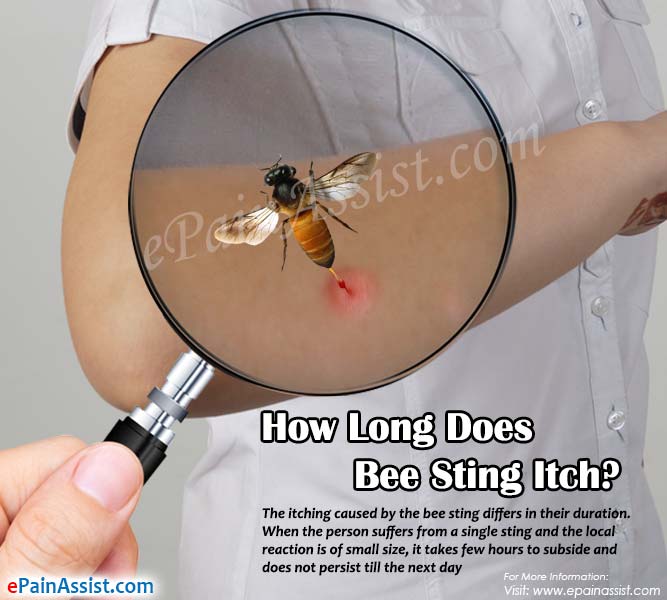Whether it is a child, an adult or an old person, almost everyone experiences a bee sting at some time in their life. A bee sting is different from an insect bite. In most cases, it can be painful and itchy, while in some cases it is harmless.
Overview of Bee Sting
A bee sting is a sharp and pointed organ present in the abdomen of a bee. Generally, bees are not aggressive and do not sting a person while away from their hives. Only when they perceive some threat to their hives that they sting the person. It is a type of a defensive action. The victim will then suffer from either single or multiple stings. The release of pheromones at the site of the sting attracts more honey bees which results in multiple stings to the victim. During this course, the bees leave the sting at that site and release toxin, which causes extreme pain, burning sensation and itching.
Generally, only the queen and the female worker, honey bees have capability to sting. Honey bees cannot pull back the barbed sting out once it stings a person. The sting is left behind in the skin at the site of the sting, along with its venom filled poison sac abdomen, digestive tract and muscles. The barb continues to go deep into the skin and the venom too continues to be injected. The large abdominal damage leads to the death of the honey bee after stinging.
Different types of bees such as the honey bees, wasps and bumble bees produce different reactions in the body of the victim. The honey bee’s sting is acidic while the sting of a wasp is alkaline. The difference in the chemical nature of the stings of different species produces different reactions. In severe cases, it leads to allergic reactions which can be life threatening.

How Long Does Bee Sting Itch?
The itching caused by the bee sting differs in their duration. When the person suffers from a single sting and the local reaction is of small size, it takes few hours to subside and does not persist till the next day. While when the local reaction leads to a large swelling (>3 inches in size), it generally lasts for 2 to 3 days and takes a week to subside. In such cases, the physician should be consulted.
Reactions of a Bee Sting
The stings of bee produce different types of reactions which range from temporary pain to severe allergic reaction. The reactions range as mild, moderate and severe. Mild reactions to bee sting get healed within few hours, moderate reactions to bee sting tend to resolve over 5 to 10 days and severe reactions are often life- threatening and require urgent medical attention. The bee sting leads to different symptoms such as:
Symptoms of Mild Reactions to Bee Sting
- Immediate sharp pain at the site of the bee sting.
- Redness and swelling at the site of bee sting.
Symptoms of Mild Reactions to Bee Sting
Symptoms of moderate reactions of a bee sting include extreme redness and swelling at the site of the sting which stays for a prolonged time.
Symptoms of Severe Reactions to Bee Sting
Along with redness and swelling one experiences the following symptoms of bee sting having a severe reaction:
- Hives.
- Vomiting and nausea.
- Difficulty in speaking.
- Difficulty in breathing.
- Loss of unconsciousness.
A person can suffer from multiple stings too, which leads to the accumulation of the toxin that may induce a toxic reaction and will make a person feel highly sick. The symptoms of bee sting in this case will involve headache, fever, dizziness, nausea and vomiting and may lead to an emergency situation.
What to do for a Bee Sting?
The following steps can be followed in case of the mild to moderate bee sting:
- In case of the bee sting, the stinger must be removed immediately. It should not be removed by using fingers, but by using the hard edge of credit card or a blunt butter knife. If the little black dot is still present in the wound, it means that the stinger is still present.
- The area of bee sting should be cleaned with soap and water. Antiperspirants should be applied to reduce the effect of bee toxin.
- Cold compress or ice cubes should be applied for 30 minutes in the area of bee sting.
- For pain, pain killers such as paracetamol can be given.
- In case of lot of multiple bee stings, anti-histamine tablets are given.
- Lotion such as lactocalamine can be applied to the site of see sting.
- In case of the severe symptoms such as the allergic reactions, one should seek medical attention immediately having required to be admitted to the hospital.
Prevention of a Bee Sting
The following are the tips to avoid bee sting:
- Bees usually get attracted to the children with sweet scent. One should avoid fragrances of hair sprays, scented soaps, and oils which attract bees.
- One should not wear bright floral color prints since such patterns attract the bees.
- The cans of soda or sweet attract bees. Thus, one needs to be careful while using cans of sweetened foods or drink while sitting in the garden.
- In case if a bee is near, one should stand still and not make a movement.
- Also one should wear shoes and long pants in the area where there are bees.
Conclusion
Bees are usually harmless creatures and works for providing honey, which has numerous benefits. However, a sting of a bee is definitely a nuisance since it causes pain, discomfort and can be lethal too. There are ways to prevent it. Most of the times, a mild and moderate bee sting can be treated effectively. However, the severe cases of bee sting are difficult to treat and often require medical intervention.
